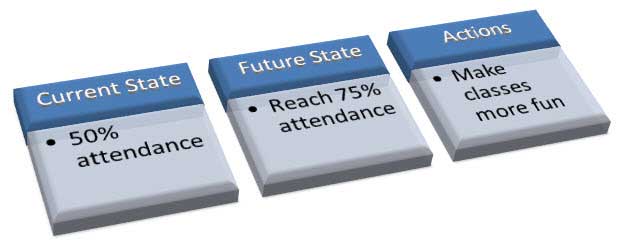Gap Analysis is a simple tool which can help you identify the gap between your current performance and desired performance in future along with the actions which will bridge the gap between them. Gap Analysis is used in commencement of the project when developing business plan. It is crucial when determining what actions need to be done to complete the project.
It can be used by businesses, universities, institutions to reach a desired future state. It can both be qualitative and quantitative.
To conduct a Gap analysis, you must first asses your current performance and decide the level of performance you desire to behold.
Gap analysis is done via 3 column chart.

GAP analysis can be made more detailed depending on the task involved and can be repeatedly used on smaller and smaller tasks.
To create a Gap analysis, you must first choose your future goal. A simple example can be like reaching the profit of 1000$ per day or increasing the enrollment of 500 students a year. Once decided, look at your current performance, your school may be having 300 enrollments per year. Lastly you assess what you have to do to close this gap.
Step1
One the template list all the factors you would like to see improved under the current state heading.
Step2Current State:
Current State is how you are performing right now. For example delivering 50 orders an hour, stringent workplace policies, 50 percent attendance in class room. The more specific and factual you are with an emphasis on identifying weaknesses, the better you will be able to formulate the solutions.
1. Concentrate on:
2. Who has the knowledge of the current situation? Who knows the big picture?
3. Is information documented or in people’s heads.
4. How to get information? Brainstorming workshop? Individual inteviews? Audit reports etc?
Step3Future State:
Future state describes what you want to achieve. To set your goals you must consider into account whether
1. The goal is feasible?
2. Whether you have the finances?
3. Whether you have enough resources or not?
4. Is it in accord with company policy?
Step4Identifying the Gap:
Once the states are defined, identify the amount of gap quantitatively. Sometimes a simple yes/no can also be suffice. Once you know where you are and what you want to achieve, you can look for what factors are causing the gap.
Step5Factors Responsible for Gap:
Here you list the factors responsible for the Gap in performance. For example low salaries or tough working hours. List should be objective and specific.
Step6Remedies:
Once the factors responsible for sluggish performance are known, it’s easier to formulate remedies.
Provide appropriate amount of detail in your GAP analysis for people to properly understand the scope of the project. With too much information it becomes difficult to make sense, with too little information, no one can make sense
When analyzing current and future situation, use quantifiable metrics, and general statements when metrics aren't available (such as "creativity is valued within the organization.").
Also remember that your assessment of the current situation and the desired future state can be both quantitative and qualitative.
Remedies must be action oriented and to the point.
Two other templates have been self created

Ask the Community
Still get confused or have more suggestions? Leave your thoughts to Community Center and we will reply within 24 hours.